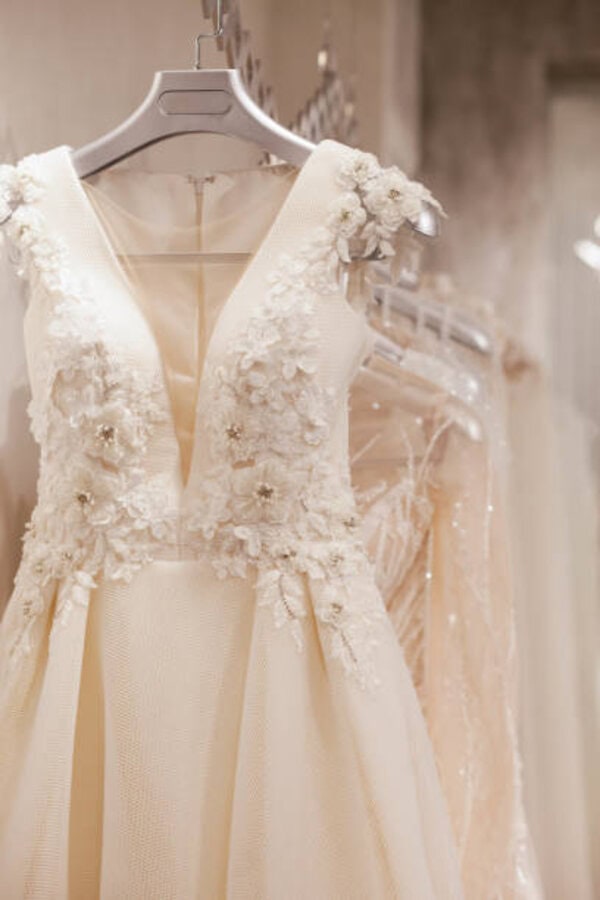
Why and How to Preserve Your Wedding Dress
Do you agree that your wedding is not just a piece of clothing but is also a witness of your love, commitment and joy of your beautiful day? If yes, then you may know that your dress will face yellowing, stains, and fabric damage with time.
Preserving your wedding dress ensures that your cherished memory remains intact, can be appreciated for years to come, and can be passed on to future generations. Additionally, the dress’s beauty and sentimental value remain forever with proper preservation and careful cleaning, stain removal, and fabric repairs.
By trusting professionals with your gown, you ensure your treasured memories stay vibrant and protected for the future. If you are still wondering why and how to preserve your wedding dress, then you have come to the right place. Here, as part of our After The Wedding tips section, we’ll discuss the important aspects of wedding dress preservation.
Why Preserve Your Wedding Dress?
-
Sentimental Value
Your wedding dress is a tangible reminder of your special day. Every time you look at it, you’ll be transported back to the moments filled with joy, love, and celebration. If there was a big survey conducted on what’s the most important thing for a bride, I’m pretty sure it would be the wedding dress. Preserving your dress helps keep these memories fresh and vivid.
-
Family Heirloom
Many brides hope to pass their wedding dress down to future generations. A well-preserved dress can become a treasured family heirloom worn by daughters, granddaughters, or other loved ones. This tradition can create a deep sense of connection and continuity within the family.
-
Financial Investment
Wedding dresses often represent a significant financial investment. Preserving the dress helps protect this investment, maintaining its condition and value over time. This can be particularly important if you sell or donate the dress.
How to Preserve Your Wedding Dress
Proper wedding dress preservation involves several steps, from immediate post-wedding care to long-term storage. Here’s a detailed guide to help you preserve your gown effectively.
Immediate Post-Wedding Care
Prompt Cleaning
- Act Quickly: It’s crucial to have your dress cleaned as soon as possible after the wedding to prevent stains from setting in. Common stains include sweat, makeup, food, and drinks.
- Professional Cleaning: Take your dress to a professional cleaner who specializes in wedding gowns. They will use gentle, fabric-specific cleaning methods to remove stains without damaging the delicate materials.
Handle with Care
- Minimize Handling: Avoid excessive handling of the dress to prevent oils and dirt from your hands transferring to the fabric.
- Protect Delicate Areas: Be mindful of intricate details such as lace, beading, and embroidery, which can be particularly vulnerable to damage.
For more useful tips – read this.
Professional Preservation Services
Choosing a Preservationist
- Experience and Reputation: Look for preservationists with extensive experience and positive reviews. Ask for references and check their track record with wedding gowns.
- Certified Specialists: Some organizations certify wedding gown preservationists, ensuring they follow industry standards and best practices.
The Preservation Process
- Detailed Inspection: A professional preservationist will carefully inspect your gown for stains, damage, and fabric type.
- Cleaning: They will use specialized cleaning techniques tailored to the specific needs of your gown’s fabric and embellishments.
- Repairs: Any necessary repairs, such as fixing loose beads or reinforcing delicate areas, will be performed.
- Packaging: Once cleaned and repaired, the gown will be carefully packaged in acid-free tissue paper and placed in an archival-quality preservation box. This packaging prevents yellowing and protects the dress from environmental damage.
Long-Term Storage Tips
Choose the Right Location
- Calm, Dry Environment: Store your dress in a cool, dry place with consistent temperatures to avoid moisture and mildew. Avoid attics, basements, and garages. Read this for more tips.
- Dark Space: Keep the dress away from direct sunlight, which can cause fading and discolouration.
Proper Storage Materials
- Acid-Free Materials: Use acid-free tissue paper and boxes to prevent the fabric from yellowing over time.
- Avoid Plastic: Do not store your dress in plastic bags or covers; they can trap moisture and lead to mildew growth.
Flat Storage
- Avoid Hanging: Store the dress flat to prevent fabric stress and distortion. If hanging is necessary, use padded hangers and ensure the dress is fully supported.
Regular Inspections
- Periodic Checks: Inspect your dress every 6-12 months to ensure it remains in good condition. Look for signs of yellowing, mould, or fabric deterioration.
- Repack if Necessary: If you notice any issues, address them immediately. Repack the dress if the packaging materials show signs of wear or damage.
Watch this video to learn how to store your dress:
DIY Preservation: Pros and Cons
While professional preservation is recommended, some brides may preserve their gowns themselves. Here are some pros and cons of DIY preservation:
Pros
- Cost-Effective: DIY preservation can be more affordable than professional services.
- Personal Control: You have complete control over the process and can ensure every step meets your standards.
Cons
- Expertise Required: Proper preservation requires knowledge of fabrics and cleaning techniques.
- Risk of Damage: Without professional equipment and materials, the gown is more likely to be damaged.
Conclusion
Preserving your wedding dress is a meaningful way to honor and cherish the memories of your special day. Whether you aim to pass the dress down as a family heirloom or simply keep it as a cherished memento, proper preservation ensures that your gown remains beautiful and intact for years. By taking immediate post-wedding care, choosing the right professional preservationist, and following long-term storage tips, you can safeguard your wedding dress and the precious memories it represents.






